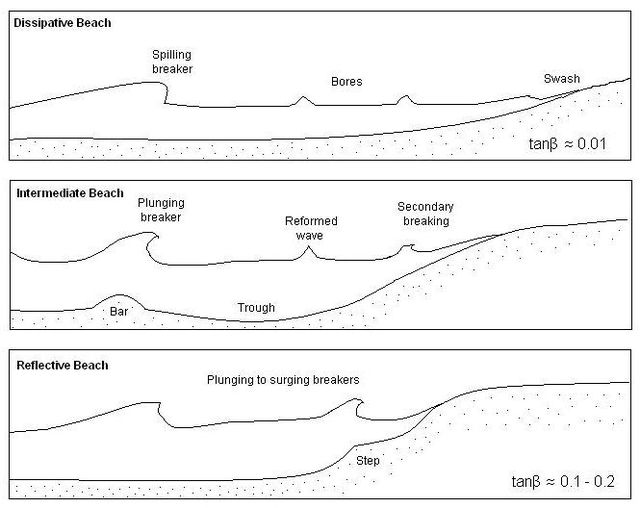Swash, or forewash in geography, is a turbulent layer of water that washes up on the beach after an incoming wave has broken. The swash action can move beach materials up and down the beach, which results in the cross-shore sediment exchange. The time-scale of swash motion varies from seconds to minutes depending on the type of beach. Greater swash generally occurs on flatter beaches. The swash motion plays the primary role in the formation of morphological features and their changes in the swash zone. The swash action also plays an important role as one of the instantaneous processes in wider coastal morphodynamics.
Swash
Figure 1. Beach classification by Wright and Short (1983) showing dissipative, intermediate, and reflective beaches.
Figure 2. Swash zone and beachface morphology showing terminology and principal processes (Modified from Masselink & Hughes 2003)
Figure 3. Beach cusp morphology. Uprush diverges at the cusp horns and backwash converges in the cusp embayments. (Modified from Masselink & Hughes 2003)
A beach is a landform alongside a body of water which consists of loose particles. The particles composing a beach are typically made from rock, such as sand, gravel, shingle, pebbles, etc., or biological sources, such as mollusc shells or coralline algae. Sediments settle in different densities and structures, depending on the local wave action and weather, creating different textures, colors and gradients or layers of material.
Recreational beaches, such as this one in Fort Lauderdale, Florida
St Oswalds Bay, Dorset, England. Wild sand and shingle beaches are shaped and maintained naturally by wave actions.
Marine debris on a beach in Hawaii.
Quartz sand particles and shell fragments from a beach. The primary component of typical beach sand is quartz, or silica (SiO2).








